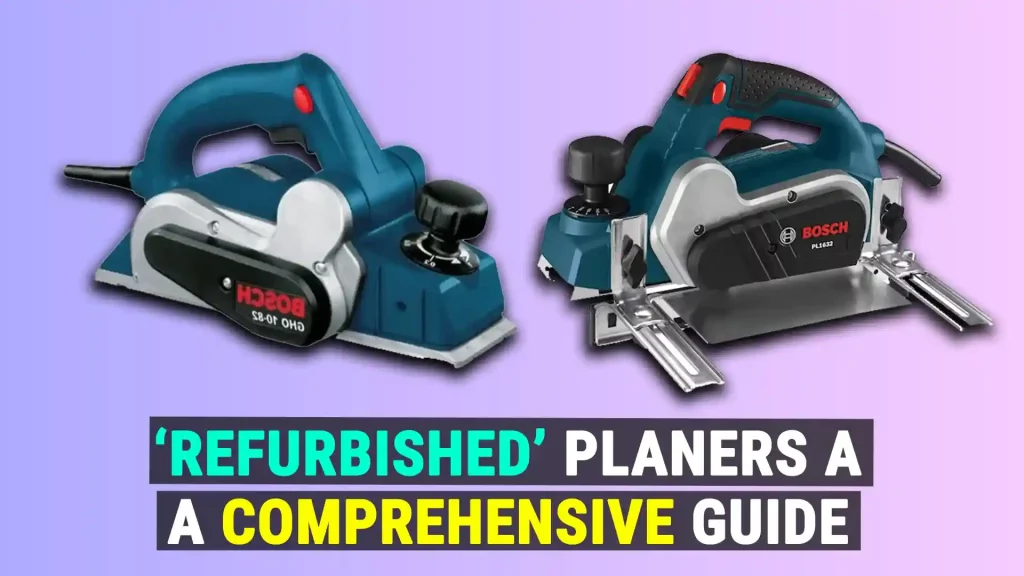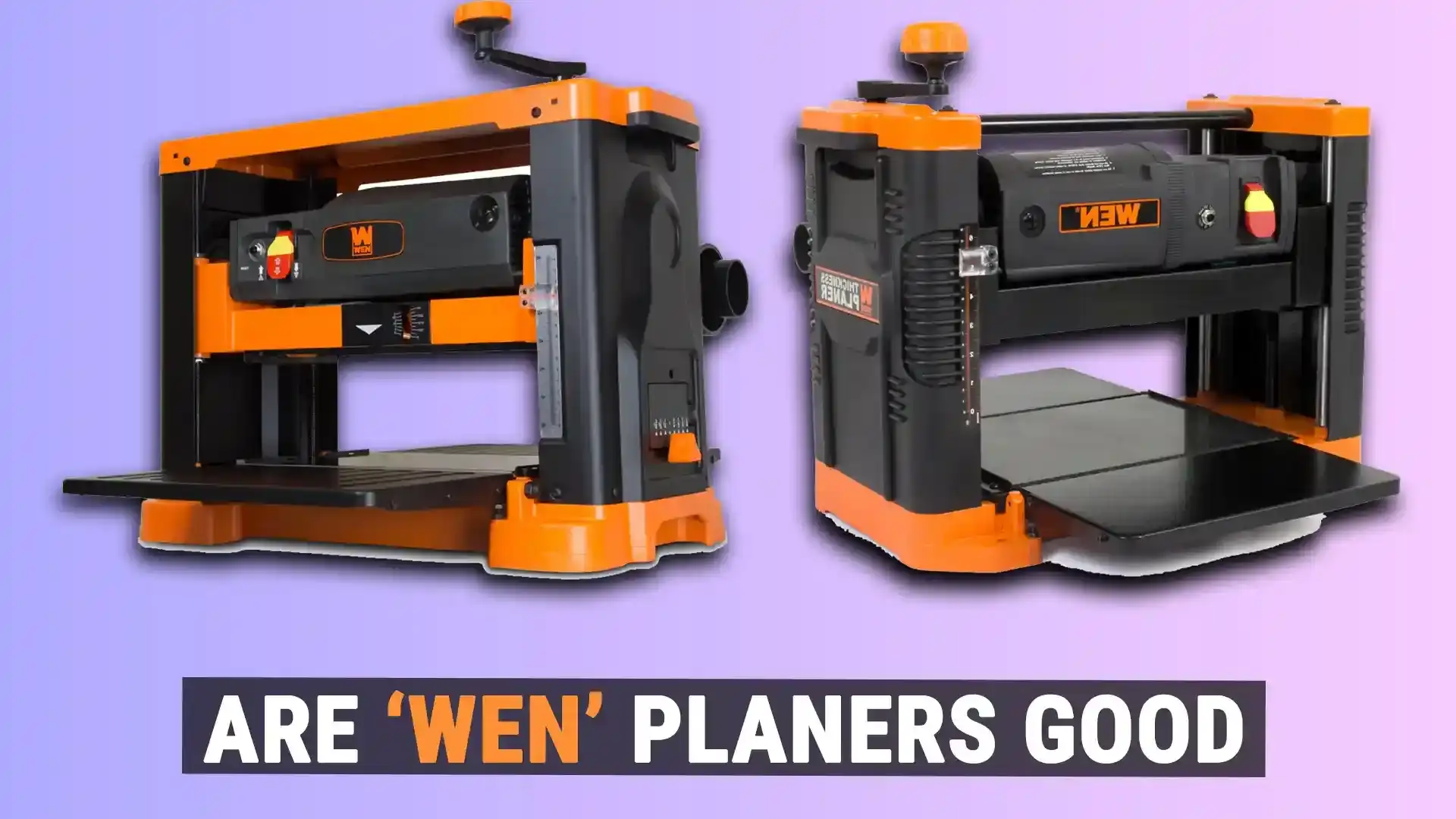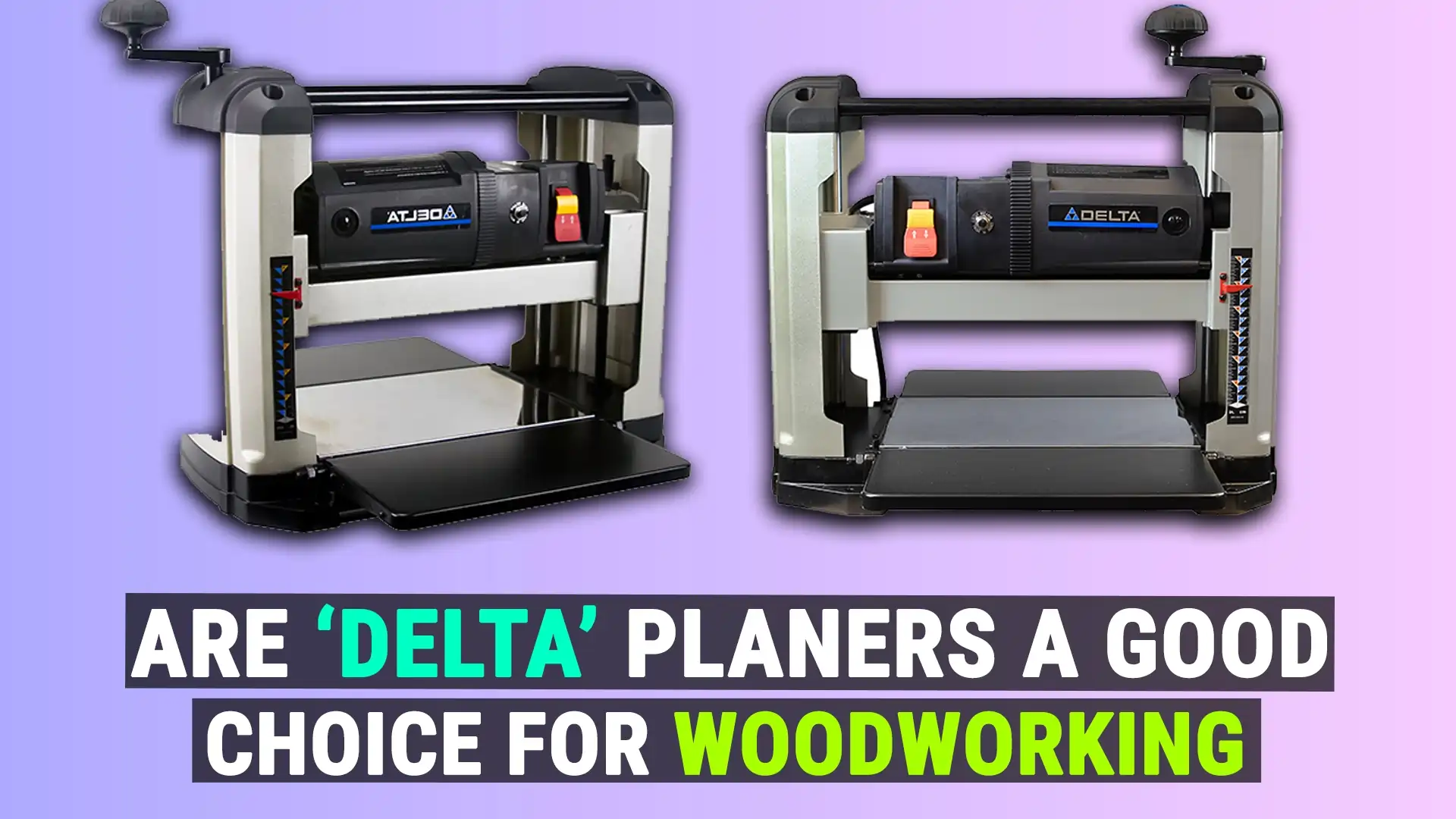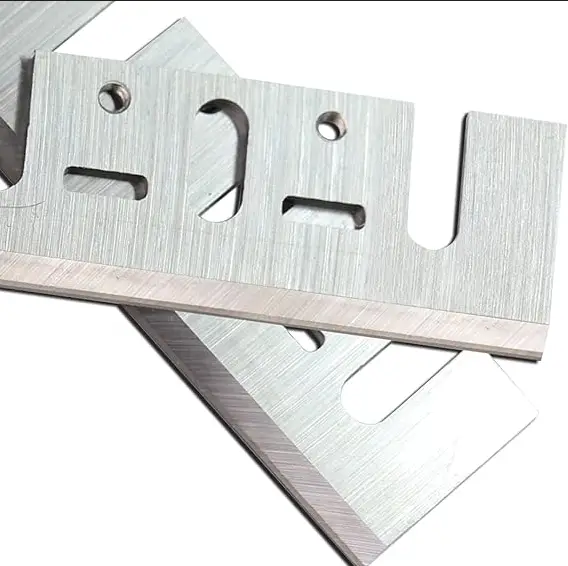Refurbished Planers Surprising Pros & Cons
A refurbished planer is a woodworking power tool that has been previously owned and used, but has been restored to like-new condition by the manufacturer or a third-party.
Refurbished planers undergo thorough inspection, testing, repair, replacement of any defective parts, and a deep cleaning. The goal of refurbishment is to bring the tool back to full working order and excellent cosmetic condition.
Refurbished planers provide significant cost savings compared to brand new models. However, it’s important to purchase refurbished equipment from a reputable source that provides transparent information on the refurbishment process and warranty. When opting for a refurbished planer, key factors to consider include the quality of refurbishment, warranty coverage, price savings, and tool age/hours of use.

How Refurbished Planers Are Restored
The refurbishment process for planers involves several key steps:
- Inspection – The planer is thoroughly examined to identify any defective, broken, or worn out parts. This includes inspecting the cutterhead, knives, bearings, motor, belts, bed, rollers, and all other functional components.
- Testing – The planer undergoes electrical, mechanical, and functionality testing to verify performance. Test cuts are made to check cut quality.
- Parts Replacement – Any parts that are defective, badly worn, or no longer up to specifications are replaced with new OEM parts. This may include knives, bearings, belts, rollers, pulleys, gears, and more.
- Deep Cleaning – The planer goes through a deep cleaning process to remove dust, grime, rust, and any other buildup. The components are cleaned and lubricated.
- Assembly & Inspection – Finally, the planer is reassembled, double checked for proper assembly, and a final multi-point inspection is performed. Test cuts are done to verify performance.
- Packaging – The refurbished planer is packaged up with necessary accessories, manual, warranty card, and any other items that would come with a new model.
The end goal is a planer that looks, functions, and performs like new. High-quality refurbishment makes the tool like-new both cosmetically and mechanically.
Pros of Buying a Refurbished Planer
Purchasing a refurbished woodworking planer has several advantages:
Significant Cost Savings
The most notable benefit is the lower price compared to a brand new planer. Refurbished planers typically offer 40-60% savings off the list price of a new model. For example, a planer that retails for $600 new may be available refurbished for around $250-$350. For woodworkers on a tight budget, those savings can make these tools much more accessible.
Refurbished Tools Are Functionally Like-New
A properly refurbished planer should perform virtually like new. All of the internal components have been inspected, repaired, and replaced as needed. Test cuts are done to verify sharpness and cutting accuracy. You’re getting like-new functionality at a used price.
Shorter Break-In Period
With a resharpened cutterhead and replaced bearings/belts, the break-in period will be shorter than a brand new machine. The difficult initial break-in cuts have essentially been done by the reconditioning process.
May Still Have Warranty Coverage
Many refurbished power tools come with a full or limited warranty providing some peace of mind. This varies by retailer, but coverage may include 90 days up to a year or more. There should at least be a guarantee that it’s in working order.
Environmentally Friendly
Purchasing refurbished keeps power tools in use and out of landfills. It’s an environmentally-conscious way to acquire equipment instead of always buying new. The refurbishing process lets quality tools have a longer usable lifespan.
What to Look for When Buying a Refurbished Planer
To find a quality refurbished planer, keep these tips in mind:
- Reputable Seller – Purchase from a trusted manufacturer, retailer, or reseller with a proven track record in refurbishment and positive customer reviews. Avoid random eBay/Craigslist sellers.
- Transparency – Look for details on what parts were replaced, how it was inspected/tested, etc. Vague or missing refurbishment info is a red flag.
- Light Use Preferred – Try to estimate past usage based on model age and condition. Lightly used is ideal vs. a heavily worn machine.
- Component Quality – Ensure cutterhead, knives, rollers and other parts were replaced with OEM spec parts, not generic.
- Warranty – Opt for a minimum 90 day warranty, longer is better for peace of mind. This shows the seller stands behind their refurb.
- Return Policy – In case there are functionality issues, check that you can easily return it for refund/exchange.
- Price Difference – Calculate the discount vs. new price and compare to other refurbs to ensure it’s a solid value.
- Cut Test – If possible, do a test cut with the actual machine first to verify sharpness, accuracy and smooth functioning.
With attention to the above details, you can more confidently choose a quality refurbished planer that will provide years of smooth and accurate service.
What to Look Out for With Refurbished Planers
While refurbished planers can provide great value, there are a few potential downsides to be aware of:
Lower Quality Refurbishment
If the refurbishment process cut corners, there could be underlying issues affecting performance. For example, a poor sharpening job on the cutterhead knives, cheap replacement parts, or inadequate cleaning/lubrication.
Possible Cosmetic Imperfections
Even with a deep cleaning, there may be some minor cosmetic flaws like scuffs, discoloration or dings that don’t affect function. If pristine condition is important, inspect closely.
Shorter Overall Tool Life Span
Assuming the planer had previous owners, the overall usable lifespan is reduced vs. buying new. There could be 5+ fewer years of life expectancy.
Limited Inventory Availability
Finding a specific planer model and size refurbished can be challenging. The selection is not as vast and changes frequently based on availability.
Small Warranty Periods
Typical refurb warranties range from 30-90 days compared with 3-5 years for a new tool purchase. Long term coverage requires buying an extended warranty.
Past User Abuse Possible
If the previous owner did not maintain and operate it properly, there could be underlying issues or premature wear despite refurb efforts. No way to know its history.
While most quality refurbs overcome the above drawbacks, it’s helpful to be aware of the potential compromises.Thorough inspection and testing is key prior to purchasing any refurbished woodworking machinery.
Examples of Popular Refurbished Planer Models
To give you an idea of what refurbished planers are typically available, here are some of the most common models to look for:
Dewalt DW735X 13″ Thickness Planer
One of the most popular portable planers, the DeWalt DW735X is a robust and precise machine. Refurbs sell for $400-$700 depending on condition, nearly half off the $900+ for a new one. Look for refurbs with minimal use.
Makita 2012NB 12″ Portable Thickness Planer
Makita’s 2012NB planer consistently gets high marks for smooth, quiet performance. Refurbished models can cost $250-$450, $200-$300 less than new. Pay close attention to prior usage hours.
Delta 22-580 13″ Portable Thickness Planer
This Delta planer combines power and precision at a reasonable price point. Refurbs are commonly priced between $200-$350. Expect $150-$250 savings versus new. Low-use refurbs are ideal.
Ridgid R4331 13″ Portable Thickness Planer
The heavy duty R4331 gets high marks for cut quality and smooth operation. Refurbs often cost $300-$450, nearly half off the $800+ for a new one. Lightly used models are best.
Wen 6550 12.5″ 15 Amp Benchtop Thickness Planer
Wen’s 6550 is a popular benchtop model combining power and accuracy. Refurbs can cost just $150-$250, $100-$150 less than new. Minor cosmetic flaws are common but performance is solid.
Grizzly G0453Z 19″ Planer/Molder Combo Machine
This industrial Grizzly machine combines a planer and molder for serious woodworkers. Refurbs run $1400-$1800 versus $2200-$2500 new. Significant savings but high initial cost.
For the best value, closely compare refurbished planer prices and warranty details to find deals. Well-refurbished models provide nearly equivalent performance to new.
Refurbished vs Used Planers: Key Differences
It’s important to understand the key differences between refurbished and simple used planers:
- Refurbs – Fully disassembled, cleaned, worn parts replaced, inspected, tested, and repackaged by manufacturer or reseller.
- Used – No formal refurbishment process. Sold “as-is” either private party or resale shops. Higher risk.
- Condition – Refurbs often look and function like new. Used can have significant wear and tear.
- Parts – Refurbs have new replacement parts where needed. Used tools have old worn parts.
- Price – Refurbs offer big discounts vs new. Used pricing varies greatly depending on wear.
- Warranty – Refurbs mostly have 90 day to 1 year warranties. Used has no warranty unless sold privately.
- Performance – Refurbs meet “like-new” OEM specs for accuracy and power. Used performance is an uncertainty.
- Resale Value – Refurbs can recoup 50-60% of purchase price if resold. Used tools often lose significant value.
While “used” planers can also offer value, refurbished models provide better performance, reliability, and resale value due to comprehensive restoration.
Is Buying a Refurbished Power Tool Risky?
Some buyers have reasonable concerns about purchasing refurbished power tools:
- Will it break down prematurely?
- Is performance really like new?
- What if critical components are worn out?
- Is there a risk of getting a lemon?
To help mitigate risks, here are some tips:
- Only buy from reputable sellers with transparent refurbishing practices and positive reviews. This minimizes the chance of improperly refurbished tools.
- Inspect tool carefully prior to purchase if possible. Make test cuts to check for vibration, accuracy, etc.
- Review warranty terms. Good refurbs should have a 6 month to 1 year warranty, some even longer. This provides a window of coverage.
- Use a credit card when purchasing for added refund protection in case issues arise.
- Ask questions about which parts were replaced and why tool was refurbished in the first place. This provides insight into its condition.
- Consider paying a little extra for “lightly used” refurbs which come with less wear vs. heavily used.
While risks are reduced by an ethical seller and thorough refurbishing process, always inspect prior to purchase when possible. However, thousands of buyers have reported great experiences with refurbished tools when proper precautions are taken.
Pros and Cons of Buying Refurbished Planers
Pros:
- 40-60% cost savings vs. new
- Solid performance if properly refurbished
- Shorter break-in period
- May have 90 day to 1 year warranty
- Environmentally-friendly option
Cons:
- Potential for improperly done refurbishment
- Limited availability of specific models
- May have minor cosmetic flaws
- Reduced overall lifespan vs. new
- Small warranty periods typically
Ideal Woods for Refurbished Planers
Refurbished planers perform especially well on the following wood species:
- Pine – Soft and easy to cut. Great for breaking in new knives.
- Maple – Hard but planes smoothly, ideal for furniture projects. Doesn’t dull cutters quickly.
- Walnut – Rich color that looks gorgeous from a planer. Machines well with sharp knives.
- Cherry – Produces nice curls. Holds details well and resists tearout.
- Red Oak – Strong and stable. Good all-purpose species for planing.
- Poplar – Versatile, inexpensive wood that planes nicely.
- Alder – Workable softwood that planes smoothly without tearout.
The optimal woods are softer, have straight grain, and plane cleanly. Avoid burls, knots, and irregular grain when possible.
Bad Woods for Planers
On the other hand, be cautious planing these woods:
- Teak – Extremely dense and oily. Will quickly dull knives.
- Hickory – Very tough and prone to tearout. Difficult grain pattern.
- Purpleheart – Hard on planer knives and tends to chip.
- Cocobolo – Oily tropical wood clogs cutters. Density wears blades quickly.
- Bubinga – Interlocked grain causes tearout. Resins build up on planer.
- Rosewoods – Most varieties are very dense and brittle. Results in chip out.
- Ipe – One of the hardest woods. Can instantly damage knives.
Save your planer knives by avoiding these exotic woods or resawing into thinner pieces first.
Planing Other Materials
While designed for wood, you can also successfully plane these materials:
- Plastics – Use a fine cut and shallow depth. Works for PVC, acrylic, polycarbonate.
- Soft metals – Aluminum planes well but make very light passes.
- Composites – Cut slowly through MDF, plywood, OSB with sharp knives.
- Foam – Use compression rollers rather than cutterhead. Good for surfacing insulation foam board.
However, avoid these:
- Glass, stone, cement – Will damage knives.
- Treated lumber – Chemicals are harmful to inhale.
- Hard metals – Can quickly ruinate cutters.
Stick with natural wood for the best performance from your refurbished planer.
Advanced Planing Techniques
Once proficient with the basics, try these more advanced planing methods:
- Edge jointing – Use a sled to plane edges perfectly square. Improves gluing up panels.
- Smoothing figured woods – Take very light cuts and adjust grain direction to avoid tearout in burls, curls, etc.
- Surfacing warped boards – repeatedly plane cupped or twisted boards to flatten them out.
- Beveling – Adjust bed to precise angles to create beveled edges.
- Thicknessing – Carefully remove thin amounts to fine-tune wood to exact thicknesses.
- Planing coated wood – First remove old finishes completely to avoid damaging knives or breathing fumes.
- Double pass method – Plane wood initially with the grain, finish by taking a light second pass against the grain.
With some experience, you can tackle specialized planing tasks with your refurbished planer.
DIY Planer Improvements
You can modify your refurbished planer to enhance performance:
- Build a planer sled – Adds support for small or thin pieces.
- Construct infeed/outfeed tables – Improves work flow and finish.
- Increase dust collection – Add a dust hood around the cutterhead.
- Improve chip ejection – Add a chip deflector to keep knives clear.
- Add mobilizing casters – Install locking casters to make the planer portable.
- Power feed modification – Add rollers before and after cutterhead to aid feeding.
- Cutterhead upgrade – Invest in a helical head for ultra-smooth finish.
- Fence attachment – Allows for straight line edging like a jointer.
With some handy upgrades, you can customize your planer to suit your unique needs.
Disposing and Recycling Old Planers
When it’s finally time to retire your refurbished planer, make sure to recycle or dispose of it properly:
- Remove all consumable parts that could be reused like blades, belts, brushes.
- Take metal components like motors, screws, plates to a metal recycling center.
- Plastics and composites may go in normal waste if no recycling option.
- Drain hydraulic fluid, oils, and lubric
The Bottom Line
When purchased through a reputable source and properly vetted, a refurbished planer can be an excellent value for woodworkers. The substantial cost savings allow those on tight budgets to still obtain high-quality, powerful, and accurate thickness planers. For safety, opt for refurbs with lighter prior use and be diligent about inspection and testing. While there are some compromises, a refurbished planer can be a smart purchase with the right diligence and expectations. They enable woodworkers to expand their capabilities at an affordable price point.




